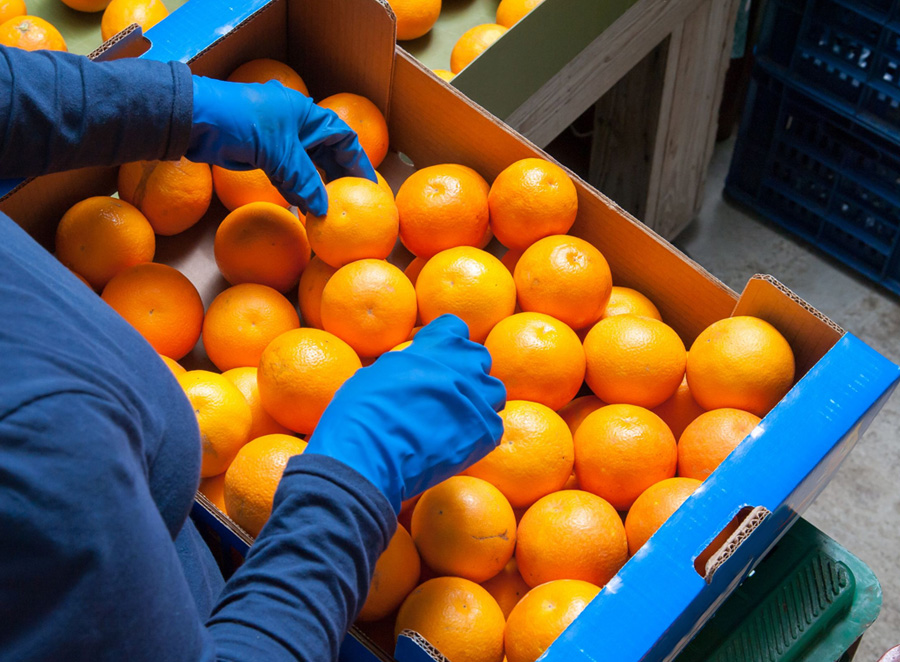What is the digitalize and secure solution?
Fresh food sales are an important growth driver for retailers, as well as a priority for shoppers who want to ensure they have an ample supply of fresh food on hand. The Coronavirus crisis redefined shopping patterns for businesses and created some new trends in the fresh food industries.
AWL India's Intelligent Supply Chain (ISC) management proposes several key traceability solutions to digitize, secure, and leverage valuable data, enabling safer, more sustainable, efficient, and transparent supply chains. The smart staff at AWL India who handle inventory management and warehousing solutions know how important it is to capitalize on a product's natural variability because it not only helps the clients increase revenues but can also reveal a lot about the industry the brand is in and the shopping habits of its target market.
The global food logistics market reached a value of US$ 100.1 Billion in 2021. The market is projected to grow at a CAGR of 8% between 2021 and 2026. Means, the food logistics market size has the potential to grow by USD 55.86 billion during 2020-2024, and the market’s growth momentum will accelerate during the forecast period.
Key-Takeaways
- Trends in the food logistics market.
- The major obstacles in the food supply chain
- Awl India’s inventory management solutions
- Warehousing smartness
- Data Warehouse in Supply Chain
TRENDS IN THE FOODS LOGISTICS MARKET
1. Price and regularity are equally important
Businesses are accustomed to receiving fresh food delivered swiftly or to receiving even the most unusual consignments on the same day. However, fresh foods and grocery stores and businesses place even more value on timeliness. Overall, we see that lower-income nations typically spend a substantially higher proportion of their budgets on food; countries with per capita GDPs under $5,000 typically spend more than 30% of their budgets on food. Seeing the opportunity, AWL India makes sure that supplies are transported to B2B at the proper time so that businesses can run smoothly, and their customers are satisfied. Some food distributors are unable to consistently fill customers' orders with the necessary products, which creates a clear disadvantage, or they are unable to meet the time frames in which customers require their deliveries. Which results in experiencing a decline in sales and profits. However, AWL offers the most dependable, quick, and secure service, ensuring the quick and fresh delivery of client products.

2. HYBRID ROUTING WILL AID IN MEETING DELIVERY DEADLINES
Vehicle Routing Problem (VRP) is an NP-complete problem and has important practical value. More and more of the VRP research is attention because many real-life problems can be attributed to VRP. The capacitated vehicle routing problem (CVRP) is one of the elemental problems in supply chain management. The objective of CVRP is to provide each vehicle with a sequence of delivers so that all customers are serviced, and the traveling cost of vehicles is minimized. It is hard to solve this problem directly when the number of customers is large. AWL India’s supply chain researchers have suggested improved Capacitated Vehicle Routing Problem (CVRP) by employing an ACO algorithm for its logistical supports and affiliates. A deoxyribonucleic acid computing and modified Adleman-Lipton model accelerates the search on large nodes CVRP in a decentralized model. AWL logistics fresh food retail distributors are changing their processes to get the right products into the hands of the right clients at the right time, rather than just considering static routes. Distributors can give priority to large volume (higher profit) clients with tight delivery windows by leveraging a hybrid routing process, ensuring they remain satisfied with their suppliers. Deliveries to smaller, more adaptable businesses can then be dynamically routed to level load the fleet.
3. AI WILL BE THE ENGINE FOR IMPROVED PERFORMANCE
According to 40% of respondents, artificial intelligence can help inventory & warehouse management in logistics sector. Businesses may build more intelligent production and distribution facilities by implementing AI. In other words, AI can comprehend intricate real-time dynamics of inventory control, forecast possible outcomes, suggest course of action, and take appropriate action. If football is a game of inches, then food distribution is a game of minutes distributors will not only meet or beat their clients' expectations, but they will also be more productive, the more precise they can be with their routing. To better plan the supply chain, artificial intelligence (AI) and machine learning (ML) of AWL are being used to leverage data, including insights about other mitigating factors, such as storage conditions, temperature control, weather, traffic, and more, in addition to the stats accumulated. By streamlining the procedure, these technologies can improve the number of processes during a typical day. AWL uses software and technology to guarantee a secure, effective, and dependable global cold food and beverage supply chain ecosystem. According to McKinsey, successful AI deployment has lowered logistical costs by 15%, increased inventory levels by 35%, and raised service levels by 65% for firms. Only 12% of companies, according to the 2020 MHI Annual Industry Report, use AI technology in their warehouses, but that number is predicted to rise to 60% or more in just six years.
Major Obstacles in Fresh Food Supply Chains
While health-conscious consumers will always drive fresh food demand, spoilage remains one of the most serious threats to fresh food supply chains. However, keeping things fresh is only the tip of the iceberg. It imposes many challenges on the supply chain that must be met effectively.
Inferior Sourcing
While the fresh foods market is thriving, it also has one of the most complicated supply chains to manage. Because fresh produce is perishable, fresh food retailers must walk a tightrope when it comes to storage, transportation, and shelf management.
The U.S. cold storage market size was estimated at USD 30.26 billion in 2021 and is expected to reach USD 33.08 billion in 2022. So, what is the U.S. cold storage market growth? The U.S. cold storage market is expected to grow at a compound annual growth rate of 9.2% from 2022 to 2030 to reach USD 66.74 billion by 2030.
AWL focused on sourcing fresh produce strategically, considering seasonal demand fluctuations, supplier costs, and supplier location. We follow the sequence that every supplier relationship should be based on the product's supply, quality volatility, and volume volatility. Products with high supply volatility should be sourced from stable suppliers, whereas less volatile products can be sourced through transactional or even spot-market purchasing, this allows us to respond to changes in demand.
Holding Freshness and Quality
The frozen segment accounted for the largest share exceeding 82.27% in 2021. In terms of food freshness, it is critical to keep fresh foods at the proper temperatures and humidity levels throughout the supply chain. Fruits such as lemon, grapes, and apples require temperatures ranging from 0 to 2 degrees Celsius and humidity levels ranging from 90% to 100%. Garlic, on the other hand, must be stored at a similar temperature but at humidity levels ranging from 65% to 75% because high humidity is harmful to them.
AWL provides seamless food and beverage warehouse solutions with comprehensive temperature-controlled and cold chain storage, backed by years of experience and a passionate team of professionals. It makes AWL to be one of the leading warehouse service providers. We provide a wide range of storage and packaging solutions for a wide range of food products to extend their shelf life and preserve their freshness.
Containers, Shipments, and Transportation Problems
Fresh foods are available in a variety of forms and must be packaged and shipped following their durability and nature. Fresh fruits and vegetables, such as cherries, pineapples, pears, muskmelon, and onions, can be easily packaged in wooden trays. Softer fruits, leafy vegetables, eggs, and tomatoes, on the other hand, must be packaged and handled with care.
Once these foods are packaged, AWL ensures that they are distributed ideally, keeping in mind that some foods cannot be shipped together, while others can travel longer distances, require fast transportation, or require cold storage. To that end, AWL employs advanced and technologically driven cross-docking solutions that allow for the timely distribution of perishable and temperature-sensitive food products to their destination.
Supply Chain Visibility Issues
Are you aware? Nearly 30% of premium fruits and vegetables are overlooked by supermarket chains and trade chains only because of optical flaws. One of the biggest logistical problems in the retail of fresh foods is a limitation of visibility into the supply chain.
As a result, AWL provides end-to-end supply chain visibility, allowing our logistics managers to take preventive measures to recover fresh produce in the event of a transportation delay or temperature instability at any point. Poor communication between sellers and retailers, as well as between retailers and customers, is also a result of low visibility.
AWL's Inventory Management Solutions
Method of "First in, First Out"
In this process, the Food products are manufactured in batches and labelled with a unique identification number known as the batch number. They are then stored in the inventory in the appropriate order, with older batches in front or on top, ready to ship first when ordered. The FIFO methodology ensures that fresh, high-quality food is delivered on time.
Method of “First Expiry First Out”
In this methodology, batches are shipped based on the product's shelf life or expiration date. The food batch that has been in the inventory the longest or that has the closest expiry date is distributed first.
Warehousing Smartness
Another AI technology that has received significant investment to improve warehouse & supply chain management for enterprises is warehouse robots. The market for warehouse robots, which was estimated to be worth USD 4.7 billion in 2021, is anticipated to expand at a CAGR of 14% from 2021 to 2026. AWL India offers ‘Warehouse As A Solutions’ (WAAS), automation used to manage suppliers, and AI can actively identify and react to changes in demand as they happen. WAAS is based on complete automation and technologically advanced supply chain warehousing operations that ensures all major functions like receiving, put-away, storage, inventory management, picking, packing, and distribution are effectively done and monitored.
Data Warehouse in Supply Chain
Most businesses frequently ignore the massive amounts of data that the contemporary supply chain processes create every day. warehouse consultants at AWL India claim that this data is extremely valuable and may be used to develop BI tools and offer cutting-edge analytical insights. Because business intelligence technologies are reliable, SCM data may be crucial for boosting organizational productivity. However, for BI technologies to facilitate intelligent decision-making, corporate data must be accessed quickly and effectively stored and retrieved. Traditional database solutions might not be able to meet an enterprise's expanding needs considering the sheer volume of data. Enterprises need data warehousing systems that are suited for storing and analyzing huge volumes of data to accomplish this.
Global Market Insights estimates that in 2018, the market for data warehousing solutions reached a value of $13 billion. Furthermore, at a compound annual growth rate (CAGR) of 12%, it is anticipated to surpass $30 billion by 2025. These figures unmistakably show that data warehousing solutions will continue to be essential for businesses of all kinds in the years to come.
Conclusion
Because of the rising demand for safe storage, quick logistics and intense market competition, digitization of the fresh food supply chain is more important than ever. It is essential to keep all food and beverages fresh and tasty. As a result, we at AWL promise to provide first-rate supply chain management to ensure product integrity and boost businesses’ reputations. Our strategic approach to temperature-controlled storage, combined with real-time inventory visibility and tracking, differentiates us as the best in the industry. Also, because of the introduction of AI into the whole equation, supply chain management at AWL has reached to its pinnacle providing, best-class logistics, warehousing and cold-storage services ans is now one of the best warehouse logistics companies.

Rituraj Pankaj
Tech Leader in Supply Chain Management




